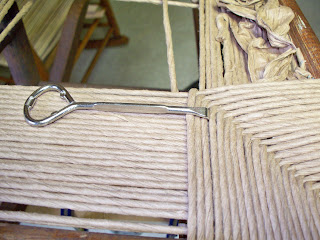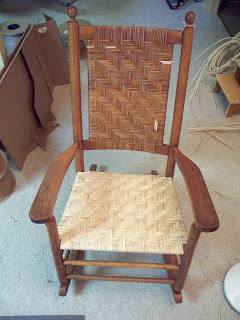Thursday, December 20, 2012
Delicate Ladderback for Rush.
This is a handsome, delicately built ladderback to have a new rush seat installed. 15" seat, 6/32" rush, with 3 coats of clear shellac.
Double Rung Footstool
Customer said that this stool was woven over both rungs. My solution to the wide blank edges was to weave in 1 piece checkerboard style, after weaving the seat pattern. I was not successful weaving in another strand, thinking that the long faces would look good with 3 strands.
This is a 15" seat, and 5/8" reed, varnished with semi-gloss. No stain was desired by the customer.
I am happy with the result.
Thursday, August 2, 2012
Child's Arm Chair with handwoven Cane Seat
What a handsome little handmade, handcarved child's chair with broken cane seat. The posts were turned and then carved. The arms and back ore carved as well.
On close inspection, the # of holes in the back rail is uneven and hence has a center hole, but the front rail has an even # of holes and hence has 2 center holes. The seat was originally woven on a slant because the weaver had to choose a center hole in the front. Likewise, 1 side rail has 1 more hole than it's opposite side. Also. the corner post locations for 2 diagonals have no holes and these strands were glued in place.
The holes for the caning were drilled diagonally into the inside of the frame so the caning would be concealed underneath the seat.
The binder cane was nailed to the 4 corner posts,
Other than that, it was a straightforward caning project!
On close inspection, the # of holes in the back rail is uneven and hence has a center hole, but the front rail has an even # of holes and hence has 2 center holes. The seat was originally woven on a slant because the weaver had to choose a center hole in the front. Likewise, 1 side rail has 1 more hole than it's opposite side. Also. the corner post locations for 2 diagonals have no holes and these strands were glued in place.
The holes for the caning were drilled diagonally into the inside of the frame so the caning would be concealed underneath the seat.
The binder cane was nailed to the 4 corner posts,
Other than that, it was a straightforward caning project!
Monday, May 7, 2012
Tuesday, March 6, 2012
Hong Kong Grass Seat-Mover Damaged
Next project. Reweaving a seat damaged in a move--really damaged!
Hong Kong Grass or Twisted Sea Grass is the material.
Hong Kong Grass or Twisted Sea Grass is the material.
Binder Cane Rocker -New Seat,Repaired Back
Recently completed reweaving the seat and patching in several broken strands in the back. Stained to match the existing back.
This is a 7x7 weave.
The front rung of this seat was broken and replaced with an oak rung prior to the reweaving.
Wednesday, February 29, 2012
Small rocker, Fiber Rush Seat
Small rocker with replacement seat of fiber rush. Precision weaving with attention to all details is the secret to rushing.
Monday, February 27, 2012
Pretwisted Natural Rush Seat
This material is quite variable in dimension and is nowhere near a nice as hand twisted bullrush or cattail.
Pleased with the final result here, but not anxious to use it again.
Pleased with the final result here, but not anxious to use it again.
Friday, February 24, 2012
Tools and Quick Tips for Rushing
Here is the ubiquitous Paint Can Opener which can pull strands of rush into proper alignment or adjust a corner. Especially useful underneath to organize the forgotten bottom strands and produce a really professional finish.
Here again is the rush packer for compression. Lightly hammer toward the corners and keep the measurements even for each quadrant as the rush builds toward the center.
 |
| Paint Can Opener pulling strand |
 |
| Paint Can Opener |
Here again is the rush packer for compression. Lightly hammer toward the corners and keep the measurements even for each quadrant as the rush builds toward the center.
 |
| Rush Packer |
Saturday, February 18, 2012
Compromises --Plywood Seat instead of Cane
This is the compromise which the customer and I agreed on to avoid removing wood to access the groove to recane this seat which is pictured in a previous post. We can always come back and recane in the future, but cost and usage entered into this decision.
1/4" plywood lightly bradded in place. Chair has always had a cushion.
This is a correction to a former post.
1/4" plywood lightly bradded in place. Chair has always had a cushion.
This is a correction to a former post.
Upgraded Workstation for Rushing
While attending the Gathering of the Seatweavers' Guild in Indiana last summer, I observed a bench similar to this being used for rushing. It provides a stable base for securing a chair and doing the necessary pulling, tugging, and packing involved in good rushing technique. After chasing several unsecured chairs around the top of my canvas covered bench, I broke down and went to the garage to scavenge some poplar and melamine surfaced chipboard. Now I have an efficient workstation. The height is customizable by changing the length of the pipe nipples.
Second upgrade was making a semi-circular opening in the side of my hickory "compressor board" or "packer" used to compress the woven rush toward the corners to keep it close and tight. This handy tool now grabs the rush on 3 sides of the rung and a couple quick taps tightens it right up.
I also started to use 3/16" wide staples, 10mm long in an upholstery stapler(BostitchTU97) to secure lengths of rush to the rungs instead of hand driven tacks. Much faster and less frustration. Thanks to Katherine at seatweavingrestoration.com for that tool tip.
Monday, January 23, 2012
Footstool with different Fill-In
This footstool has 3/8" flat reed in a herringbone 3x3 and skip 1 pattern. The edges are filled in with 3 wraps over the edge, woven through, and wrapped under the edge. I'm thinking to fill in with 3 strands individually as free strips, not woven over the edges.
Anyone seen this pattern?
Subscribe to:
Posts (Atom)































